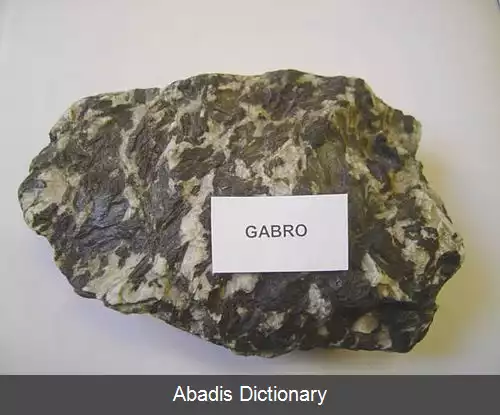گابرو سنگ دانه درشت آذرین قلیائی است که از نظر شیمیایی با بازالت همانند است. [۱]
سنگ گابرو زمانی تشکیل می شود که گدازه های آتشفشانی در زیر سطح زمین گیر بیفتند و به شکل انبوهه ای بلورین سرد شوند. [۲]
... [مشاهده متن کامل]
زیر بیشتر سطح کرهٔ زمین یعنی در قسمت پوسته اقیانوسی لایه ای از گابرو وجود دارد. گابرو از کانی های پلاژیوکلاز، الیوین، پیروکسین و برخی اوقات هورنبلاند تشکیل یافته است. . [۱]
منابع [ویرایش]
در ویکی انبار پرونده هایی دربارهٔ گابرو موجود است.
↑ ۱٫۰ ۱٫۱ ملکیان، فریدون، فرهنگ زمین شناسی و علوم وابسته، تهران: ۱۳۵۰خ، ص۷۷.
↑ ویکی پدیای انگلیسی، نسخهٔ ۴ اوت ۲۰۰۷.
این یک نوشتار خُرد زمین شناسی است. با گسترش آن به ویکی پدیا کمک کنید.
بخش بندی سنگ های آذرین
فلسیک مافیک
درصد سیلیس زیر ۶۸ ۶۸ تا ۶۳ ۶۳ تا ۵۲ ۵۲ تا ۴۸ بالای ۴۸
آتشفشانی ریولیت داسیت آندزیت بازالت کماتیت
نیمه ژرف گرانوفیر گرانودیوریت دیوریت دولریت پریدوتیت
نفوذی گرانیت گابرو
رده ها: سنگ شناسی سنگ های آذرین
قس انگلیسی
Gabbro ( /ˈɡæbroʊ/ ) refers to a large group of dark, coarse - grained, intrusive mafic igneous rocks chemically equivalent to basalt. The rocks are plutonic, formed when molten magma is trapped beneath the Earth's surface and cools into a crystalline mass.
The vast majority of the Earth's surface is underlain by gabbro within the oceanic crust, produced by basalt magmatism at mid - ocean ridges.
Contents [show]
[edit]Petrology
A gabbro landscape on the main ridge of the Cuillin, Isle of Skye, Scotland.
Gabbro as a xenolith in a granite, eastern Sierra Nevada, Rock Creek Canyon, California.
Gabbro is dense, greenish or dark - colored and contains pyroxene, plagioclase, amphibole, and olivine ( olivine gabbro when olivine is present in a large amount ) .
The pyroxene is mostly clinopyroxene; small amounts of orthopyroxene may be present. If the amount of orthopyroxene is substantially greater than the amount of clinopyroxene, the rock is then a norite. Quartz gabbros are also known to occur and are probably derived from magma that was over - saturated with silica. Essexites represent gabbros whose parent magma was under - saturated with silica, resulting in the formation of the feldspathoid mineral nepheline. ( Silica saturation of a rock can be evaluated by normative mineralogy ) . Gabbros contain minor amounts, typically a few percent, of iron - titanium oxides such as magnetite, ilmenite, and ulvospinel.
Gabbro is generally coarse grained, with crystals in the size range of 1 mm or greater. Finer grained equivalents of gabbro are called diabase, although the vernacular term microgabbro is often used when extra descriptiveness is desired. Gabbro may be extremely coarse grained to pegmatitic, and some pyroxene - plagioclase cumulates are essentially coarse grained gabbro, although these may exhibit acicular crystal habits.
Gabbro is usually equigranular in texture, although it may be porphyritic at times, especially when plagioclase oikocrysts have grown earlier than the groundmass minerals.
[edit]Distribution
Gabbro can be formed as a massive, uniform intrusion via in - situ crystallisation of pyroxene and plagioclase, or as part of a layered intrusion as a cumulate formed by settling of pyroxene and plagioclase. Cumulate gabbros are more properly termed pyroxene - plagioclase orthocumulate.
Gabbro is an essential part of the oceanic crust, and can be found in many ophiolite complexes as parts of zones III and IV ( sheeted dyke zone to massive gabbro zone ) . Long belts of gabbroic intrusions are typically formed at proto - rift zones and around ancient rift zone margins, intruding into the rift flanks. Mantle plume hypotheses may rely on identifying mafic and ultramafic intrusions and coeval basalt volcanism.
[edit]Uses
Gabbro often contains valuable amounts of chromium, nickel, cobalt, gold, silver, platinum, and copper sulfides.
Ocellar varieties of gabbro can be used as ornamental facing stones, paving stones and it is also known by the trade name of 'black granite', which is a popular type of graveyard headstone used in funerary rites. It is also used in kitchens and their countertops, also under the misnomer of 'black granite'.
[edit]Etymology
Gabbro was named by the German geologist Christian Leopold von Buch after a town in the Italian Tuscany region. Essexite is named after the type locality in Essex County, Massachusetts, US.
[edit]See also
Peridotite
Igneous differentiation
Fractional crystallisation
[edit]External links
Wikimedia Commons has media related to: Gabbro
Ocean drilling program gabbro petrology
Scientists find the elusive gabbro
[hide] v t e
Igneous rocks by composition
Type Ultramafic
45% SiO2 Mafic
45 - 52% SiO2 Intermediate
52–63% SiO2 Intermediate - Felsic
63–69% SiO2 Felsic
69 % SiO2
Volcanic rocks:
Subvolcanic rocks:
Plutonic rocks:
Komatiite, Picrite basalt
Kimberlite, Lamproite
P . . .


